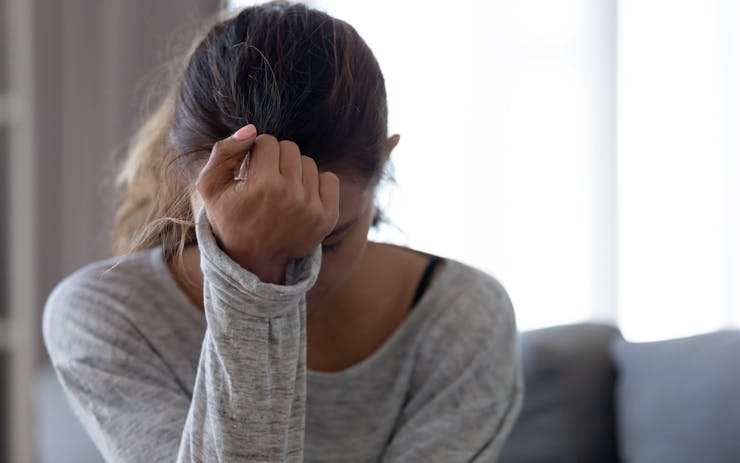Approximately 5% of Americans live with a body-focused repetitive behavior (BFRB), such as compulsive hair pulling, nail biting, or skin picking. In many cases, BFRBs are born from a need to self-soothe, and those who experience them may find themselves frequently performing a BFRB with little or no awareness of the fact.
Unlike those who self-harm, people with BFRBs typically don’t intend to inflict pain on themselves or cause physical damage to their bodies, but all BFRBs cause sufferers to repeatedly touch their hair, body, or both, in ultimately damaging ways. Depending on the BFRB, they can lead to bald spots, scarring, sores, infections, and other issues.
There’s still much to learn about BFRBs, but cannabis and hemp-derived CBD may be used to help treat these disorders, or at the very least, provide some much-needed relief to those who live with them.
Types of body-focused repetitive behaviors
While hair pulling, (trichotillomania) nail biting (onychophagia), and skin picking (excoriation) may be among the most well-known BFRBs, the TLC Foundation for Body-Focused Repetitive Behaviors states on its website that any repetitive self-grooming behavior that involves biting, pulling, picking, or scraping one’s own hair, skin, or nails and results in damage to the body can be included under the BFRB umbrella.
Dr. Laszlo Mechtler, Medical Officer of Jushi Holdings, cites lip biting, cheek biting, nail picking, scab eating, knuckle cracking, teeth grinding, and skin biting as just a few grooming-related behaviors that can be defined as BFRBs.
Causes of body-focused repetitive behaviors
“While the exact cause of BFRBs remains an enigma, it is thought that these underlying disorders are related to obsessive-compulsive disorder and are caused at least in part by anxiety,” said Dr. Mechtler.
Specifically, hair pulling and skin picking are classified under “Obsessive-Compulsive and Related Disorders” in the Diagnostic and Statistical Manual of Mental Disorders, Fifth Edition (DSM-5). However, although BFRBs share some symptoms with OCD, it should be noted that not all BFRBs are grouped under the OCD label.
Across the board, anxiety and stress seem to play a significant role where BFRBs are concerned, and depression can also be an underlying cause. Dr. Junella Chin, Chief Medical Officer of askCMD.com, said it’s important to work with a healthcare provider to find out whether a BFRB is anxiety- or depression-induced.
Shop highly rated dispensaries near you
Showing you dispensaries nearIt’s also believed that temperament, environment, age of onset, stressors, and even genetic predisposition may play a part in the development of BFRBs, according to the TLC Foundation.
In fact, a 2014 article that reviewed multiple twin and family studies found a connection between genetics and the development of OCD and related disorders, such as hair pulling and skin picking. Regarding hair pulling in particular, one study on twins reviewed estimated a 76% chance of heritability, but another estimated only 32%.
Childhood trauma has been thought to be a potential cause of compulsive hair pulling, but according to the TLC Foundation, as a whole, people with BFRBs don’t seem to experience early life trauma at higher rates than the general population.
How cannabis can help with BRFBs
Dr. Mechtler cites endocannabinoid deficiency as a possible cause of BRFBs. “The Endocannabinoid Deficiency Theory states that there are a multitude of conditions, i.e., anxiety, migraine, chronic pain, IBD, etc., which are caused in part or in whole by low levels of naturally produced cannabinoids,” he said. This theory also states that these conditions may be improved and treated by supplementing the body with plant-based cannabinoids such as THC or CBD, he said.
“A small pilot study with dronabinol found that this can be a possible treatment in reducing trichotillomania [hair pulling]. Dronabinol is a synthetic THC and it significantly reduced the impulsive behavior of the subjects in this study,” said Dr. Chin.
In the study, 14 women suffering from compulsive hair-pulling were given 2.5-15mg of the synthetic THC daily, over the course of 12 weeks. The daily dronabinol doses resulted in a significant reduction in compulsive hair pulling symptoms for nine of the women.
Regardless, it’s important to remember that THC may ease anxiety, and in turn ease BFRBs. But for some, depending on how their body interacts with cannabis, THC may increase anxiety.
Fortunately, a wealth of anecdotal evidence and a number of recent studies show that CBD-rich cannabis strains and hemp-derived CBD products can significantly reduce anxiety for most people, which means they should help provide relief for many with anxiety-induced BFRBs. “CBD may be helpful in combination with cognitive behavioral therapy to reduce stressful, obsessive, compulsive, and anxious tendencies,” said Dr. Chin.
Dr. Mechtler and his team are undertaking studies and evaluating the use of cannabinoid-based therapies for a whole host of conditions and diseases. “One consistent theme we see in our research is that use of medical cannabis products, whether that is a high-quality, third-party tested, hemp-based CBD product … or through medical marijuana-sourced state programs, typically results in a significant improvement of the study population’s anxiety,” said Dr. Mechtler. “As anxiety is likely a causal factor in BFRB, we can treat BFRBs with medical cannabis by relieving the related underlying anxieties.”
CBD products may also help by improving restorative sleeping patterns and alleviating chronic pain, said Dr. Mechtler, since both are associated with reducing anxiety levels.
While people with BFRBs may find cannabis and hemp-derived CBD products helpful, it’s recommended to involve a knowledgeable clinician in treatment decisions, as cannabis and hemp-derived CBD may not be the most appropriate treatment option. “It’s important to remember cannabis is not a panacea. Other options that a well-qualified clinician may suggest could include behavioral therapy, conventional pharmaceutical interventions, and/or supplement therapy,” said Dr. Mechtler.





